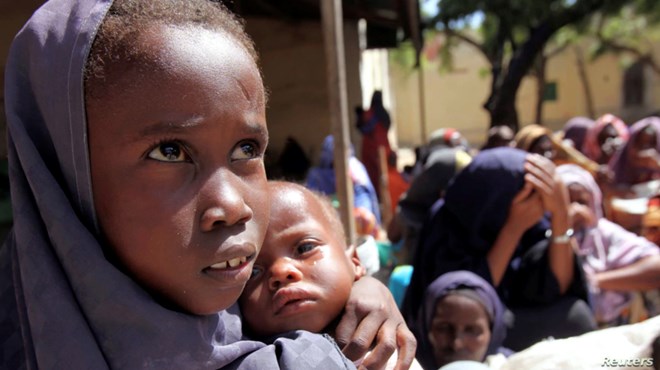
Sunday October 11, 2020

An internally displaced Somali girl carries her sibling as they wait to collect food relief from the World Food Program (WFP) at a settlement in the capital, Mogadishu, in 2011.
The world marks the International Day of the Girl Child on Sunday, during a year in which a global pandemic and subsequent economic downturn has created further challenges for girls.The United Nations, which created the day in 2011 to promote girls' rights, says difficulties already faced by girls have been exacerbated by the coronavirus health crisis, including in the areas of education, child marriage, domestic violence and economic opportunity.
A U.N. website for the observance says by next year, an estimated 435 million women and girls will be living on less than $1.90 a day – including 47 million “pushed into poverty as a result of COVID-19.”
It notes that the loss of economic prosperity and education for girls fueled by the crisis is also linked to increased levels of violence.The U.N. says even before the pandemic, one in three women worldwide had experienced physical or sexual violence. “Emerging data shows that since the outbreak of COVID-19, violence against women and girls and particularly domestic violence, has intensified.”
Child marriage
During humanitarian crises, “time and again, we see other things getting prioritized” – including food and shelter, said Lyric Thompson, a policy expert for the Washington-based International Center for Research on Women.
Thompson, who also co-chairs with Aria Grabowski, Girls Not Brides USA, part of the global coalition trying to halt child marriage, said during such times of crisis, the planning to counter “gendered forms of violence, including child marriage, falls by the wayside.”
Child marriages have been on the rise during the pandemic as COVID-related lockdowns have kept youngsters out of school and, in some cases, confined them in close quarters with sexual predators. The pandemic has also led to families trying to place daughters in more economically stable households to ease their own financial burdens.
An estimated 500,000 more girls around the world are at risk of being forced into child marriage in 2020 as a result of the effects of COVID-19, according to an October report by Save the Children.
The surge in child marriages frustrates but does not surprise Grabowski, who recommended dedicating funding and programing early on in the pandemic to combat child marriage and gender-based violence.
“So much of the health response is focused on infection prevention and control,” she said.
Few options
Rohingya refugee camps in Bangladesh are one place where child marriages have risen since the onset of the pandemic.
A refugee camp resident told VOA Bangladesh on condition of anonymity, “In some cases, families must live together in overcrowded tents in the camp. To make room, their daughters were married off before they reached adulthood."
"No parent wants to give their daughter into the hands of others, but they have to marry because of circumstances,” he added.
Wai Wai Nu, co-founder and director of the Women’s Peace Network, told VOA that the increase of child marriages in the camps is alarming.
She said parents allow their child daughters to get married not because they are poor or uneducated, but because they believe that marriage can bring security for their daughters' lives.
“Parents believe that if their daughters are married off, their husbands can protect them better than the parents could,” she said.
Domestic and sexual violence
Other forms of violence against girls are also on the rise during the pandemic, including in online spaces where more people are communicating as a result of increased social distancing.
A recent survey by Plan International found 32% of Indonesian girls have experienced violence on social media, while 56% have witnessed violence on social media. The organization surveyed 500 Indonesian girls between the ages of 15 and 20.
“Here (in Indonesia), girls do not only experience one type of gender-based online violence. Out of 500 girls, 395 said they experienced multiple instances (of violence), said Nazla Marisa, influencing director of Plan International Indonesia.
No country is immune to the abuse. In the United States, minors accounted for half the calls made in March to the National Sexual Assault Hotline operated by the Rape, Abuse & Incest National Network (RAINN). Of those claiming coronavirus concerns, “67% identified their perpetrator as a family member,” according to Harvard Medical School’s Center for Primary Care.
U.N. Women has described the gender-based violence during the global coronavirus outbreak as a “shadow pandemic.” It says since the outbreak of COVID-19, all types of violence against women and girls, particularly domestic violence, have intensified.
Education
Education is another area in which girls are suffering because of the coronavirus health crisis. Research by the Malala Fund estimates that 20 million secondary school-aged girls may never return to the classroom after the crisis is over.
The Malala fund was started by activist Malala Yousafzai, who survived a shot in the head after being targeted for campaigning for girls’ education in Pakistan.
Malala, who won the Noble Peace Prize for her efforts in 2014, spoke about the pandemic’s effect on girls education with Prince Harry and his wife, Meghan, in a video set to be released Sunday to mark the International Day of the Girl Child.
The schooling of girls is critical to advancing gender equality, according to a new, related UNESCO report. The report said that despite an increase across all levels of education, girls are still more likely to suffer exclusion than boys, an outcome it said is exacerbated by the current pandemic.
Around the world, 132 million girls are out of school, according to U.N. figures, with 1 in 3 adolescent girls from the poorest households having never been to school.
Sasmito Madrim of the Indonesian Service, Ingyin Naing of the Burmese Service, Carol Guensburg of the Africa Division, and the Bangla Service contributed to this report.